A treehouse can be a magical hideaway, fort, or play destination for almost any child, as well as a fun project for any adult. Building a treehouse takes careful planning and construction, but your hard work will pay off. If you give your dream treehouse the care and attention that it deserves, then you can build a wooden sanctuary that you can enjoy for years.
I. Preparing to Build Your Treehouse
1. Choose the right tree. The health of the tree you select is absolutely crucial for building a foundation for your treehouse. If the tree is too old or too young, you won't have the support you need for your treehouse and you will be putting yourself and anyone else who goes into the treehouse in great danger. Your tree should be sturdy, healthy, mature, and living. Ideal trees for treehouse include oak, maple, fir, and apple. It's a good idea to have an arborist inspect your tree before you start building. An ideal tree has the following qualities :
- A strong, sturdy trunk and branches.
- Roots that are deep and well-established!
- No evidence of disease or parasites that could weaken the tree.
2. Check with your local planning department. Take the time to learn about local regulations or ordinances that may be relevant to your treehouse project, such as height restrictions. You may even need a permit to build. If you have protected trees on your property, there may be restrictions on building in them.
3. Talk to your neighbors. As a courtesy, it's a good idea to speak with your neighbors and let them know your plans. If your treehouse will be visible from or overlook a neighbor's property, they will be glad you're taking their opinion into consideration. This simple step can head off future complaints and even potential lawsuits. Though your neighbors will most likely comply, this will help make them more amenable to your project.
4. Talk to your insurance agent. Make a quick call to your insurance agent to make sure that a treehouse is covered under your homeowner's policy. If it's not, then any potential damage that is caused by the treehouse won't be covered by your insurance.
II. Making a Detailed Plan
1. Choose your tree. If you're building a treehouse in your backyard, then you may only have so many trees to choose from. Once you have chosen a healthy tree, you can start thinking about the design of the house that can go on it; or you can take the opposite route and think of the design first, and then make sure that you have a fitting tree. Here are some things you keep in mind as you choose the tree for your treehouse :
- For a standard 8'x8' treehouse, choose a tree with a trunk at least 12" in diameter.
- To calculate your tree's diameter, measure its circumference by wrapping a string or measuring tape around the trunk at the point where you want the treehouse to sit. Divide that number by pi (3.14) to get the diameter.
2. Choose your design. It's important to have a firm idea of the design of your dream treehouse before you hammer in the first nail. You can find treehouse designs online, or if you're knowledgeable about building, you can create your own. You need to make accurate measurements to ensure that your design works with the tree you've selected.
- You may find it helpful to make a small cardboard model of your tree and treehouse to identify any potential issue areas.
- In creating your design, don't forget to plan for tree growth. Allow ample space around the trunk of the tree for the tree to grow. It's worth doing some research on your specific tree species to determine its growth rate.
3. Decide on your support method. There are several ways to support your treehouse. Whatever method you choose, it's important to remember that trees move with the wind. Sliding joists or brackets are essential to make sure your tree and treehouse are not damaged by winds. Here are the three main support methods for your tree :
- The post method. This method involves sinking support posts into the ground close to the tree, rather than attaching anything to the tree itself. It is the least damaging to the tree.
- The bolt method. Bolting the support beams or floor platform directly into the tree is the most traditional method of supporting a treehouse. However, this method is the most damaging to the tree. You can minimize the damage by using proper materials.
- The suspension method. In this method, you would suspend the treehouse from strong, high branches using cables, rope or chains. This method will not work for every design, and it is not ideal for treehouses that are meant to carry any significant weight.
4. Decide on your access method. Before you build your treehouse, you'll need to decide on a method of access, such as a ladder, which easily allows a person to enter the treehouse. Your method should be safe and sturdy, so this rules out the traditional treehouse ladder, which is made up of boards nailed to a tree trunk. Here are some safer methods of access for a treehouse:
- The standard ladder. You can purchase or build an ordinary ladder for climbing into your treehouse. A ladder made for bunk or loft beds can work as well.
- The rope ladder. This is a ladder made of rope and short boards, which is hung from the treehouse platform.
- The staircase. A small staircase is the safest access method if it's compatible with your vision of a treehouse. If you choose this method, make sure to build a railing for safety.
5. Figure out what you'll do with branches that interfere with your treehouse. How will you build around pesky branches? Will you cut them off, or incorporate them into the plans of the treehouse? If you decide to incorporate branches into the treehouse, will you build around them or frame them in a window? Ask yourself these questions before you start building. That way, your treehouse will reflect the care and preparation of its builder when finished.
III. Building and Securing a Platform
1. Keep safety in mind. Before you begin to build your treehouse, you should remember to keep safety in mind. Falling out is one of the biggest hazards of a treehouse. There are a few precautions you can take to make sure that everyone who is building the treehouse stays safe.
- Don't build too high. Building your treehouse too high could be dangerous. If your treehouse is going to be used mostly by children, the platform should not be any higher than 6–8 feet (1.8–2.4 m).
- Construct a safe railing. The point of your railing, of course, is to make sure that the treehouse occupants don't fall out. Make sure the railing around your platform is at least 36" high, with balusters no more than 4" apart.
- Cushion a fall. Surround the area below the treehouse with a soft natural material like wood mulch. This won't entirely prevent injury, but it will provide some cushioning for a fall.
2. Find a sturdy tree where two branches separate into a "V" shape. You'll use this tree in order to rig up your treehouse. The "V" shape will add extra strength and support, providing an anchor point at four places instead of only at two.
3. Pre-drill the tree at four different locations, on each side of the "V". Drill a 3/8" into each prong of the "V," making sure that the holes are all level. If they are not level with one another, the structure could be slanted and the support compromised.
4. Measure the distance between the holes at each side of the "V". Depending on the tree, the holes may be spaced farther or shorter apart.
5. Subtract the measurement from 10', halve the rest, and mark the distance from one end of the 2x10. Make a mark at the other end using the original measurement between the two holes in the tree. This will ensure that the 2x10s will be perfectly centered and bear equal weight when you hoist them onto the "V".
6. Create a 4" slot at each mark on both 2x10s. This is so that the trees can sway in the wind and move without damaging the structural integrity of the treehouse. Do this by drilling two 5/8" holes, each 2" to either side of your mark. Then use a jigsaw to cut between the holes, creating a 4" slot, with your mark completely centered.
- Now when the tree sways in the wind, the platform actually moves a bit to accommodate the swaying. If the platform were simply bolted onto the tree, it would move along with the tree. This is not good for the platform, as it could gradually or suddenly be pushed in different directions and begin cracking.
7. Mount two main supports to the tree at the appropriate height. Choose two sturdy pieces of 2x10 (2x12 will do, too) and place them flush against your tree. Drive four 6" or 8" long, 5/8" diameter galvanized lag screws into the four 4" slots of the 2x10 using a wrench. Place washers in between the screw and the wood board. Repeat with the other board on the opposite side of the trunk, making sure both boards are at equal height and flush with one another.
- Pre-drill both the tree and the 2x10s for an easier time installing the screws, and to minimize cracking in your boards.
- Undercut both supports at each for an aesthetic finish. Of course, do this before mounting the supports to the trunk with your screws.
- Consider doubling up each support with another 2x10 for added strength. In effect use two 2x10s on each side of the trunk, flush against one another. This allows the supports to bear more weight. If you do decide to double up on your supports, use bigger lag screws (at least 8" long and 1" diameter).
8. Place four 2x6s, evenly spaced, perpendicular across the main supports. Instead of placing them flat across the main supports, place them up on their side so they stick up two feet into the air. Secure them with 3" deck screws.
9. Attach two 2x6s to the 2x6s nailed into place above. Lay each 2x6 flush across the four ends of the 2x6s and nail them into place. Your platform should now be a square attached to the main supports. Check that your 2x6s are centered and square.
10. Attach the platform to the main supports with rafter ties. Use 8 galvanized rafter ties to attach all four of the perpendicular 2x6s to the main supports.
11. Attach the middle of the platform to the sides of the platform with joist hangers. Use 8 galvanized joist hangers to attach the ends of the perpendicular 2x6s to the abutting 2x6s.
12. Brace the platform with 2x4s. As it stands now, the platform is still a bit wobbly. In order to make the platform more sturdy, you'll need to add at least two braces. These will be attached to a lower portion of the tree and then again on both edges of the platform.
- Cut a 45-degree angle out of the top ends on each 2x4. This is so that you can attach the 2x4 to the inside of the platform.
- Form a "V" with your 2x4 so that they overlap at a straight part of the tree but also cleanly abut onto the inside of the platform.
- Attach the top of the bracing to the platform from the bottom and on the inside. Make sure both are completely flush before you drive nails into them.
- Drive an 8" lag screw through the overlapping 2x4s at a sturdy point on the tree. Use a washer between the 2x4s and the lag screw for the best results.
IV. Laying the Deck and Railing
1. Figure out where you'll need to cut around to fit the trees through your floorboards. Make a measurement of where the trees come through the flooring and cut around the trunks with a jigsaw, leaving 1" to 2" around.
2. Screw in two screws at each board end with at least 4" deck screws. Once your deck boards have been cut to accommodate the trunks of your tree, it's time to screw them into place. Use a ladder to hoist yourself up onto the platform and start screwing down with a drill. Leave a slight 1/4" or 1/2" distance between each floorboard.
3. Make an entrance from the main supports that travel past the platform. Add covering and verticals to the platform to make a rectangle. Now an awkward part that formerly jutted out of the platform has been turned into a handy-dandy entrance.
4. Use two 2x4s at each corner to start making uprights for the railing. Nail the two 2x4 (they should be at least 4 feet high) together, and then screw them to the platform at each corner.
5. Attach handrails to the uprights. Use 2x4s as well, and if you want, mitre the edges of the handrails. Then, nail them down to the uprights. Next, screw the handrails into one another through their mitered corners.
6. Attach the siding to the bottom of the platform and the bottom of the handrails. Nail any available woods - planks or plywood work fine - flush into the bottom of the platform. Then nail them into the railing at the top so that they form an effective fence.
- Use whatever you want for siding. You can successfully use meshed-together rope if you want, as long as little kiddies cannot slip through. Safety should be the first priority, especially when you're dealing with small children.
V. Finishing Up
1. Build yourself a ladder and hoist it up to the platform. There are a number of ways that you can do this. Have fun with this part of the project!
- Build a rope ladder
- Build a ladder using 2 12-foot 2x4s and 2 8-foot 2x3s. Place the 2x4s side by side in perfect symmetry, marking off where each rung should go. Cut out 2x3 notches about 1 1⁄8 inches (2.9 cm) deep into both sides of the 2x4s. Cut the 2x3s the appropriate length for rungs and glue them into their notches with wood glue. Secure your rungs with deck screws and wait for the glue to dry. Stain your ladder to give it a nice hue and protect it from the elements.
2. Add a simple roof to your treehouse. This roof is made from a simple tarp, although you can also get more elaborate in designing and constructing your roof. Drive one hook into both trunks about 8 feet (2.4 m) above the bottom of the platform. String a bungee cord between the two hooks and slip a tarp overhead.
- Next, build four outriggers several feet high and attach them to the four corners of your railing. Nail the tarp to the four corners of the outriggers, securing with a washer. Now your roof should have a better overhang.
3. Paint or stain the wood. If you want to weatherproof your treehouse, or just give it a more appealing look, now's the time to stain or paint it. Consider a stain or paint that will work in combination with your house.


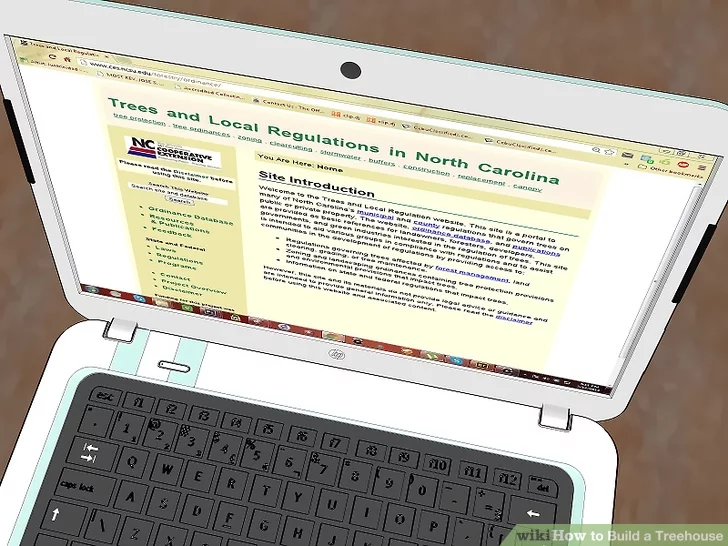

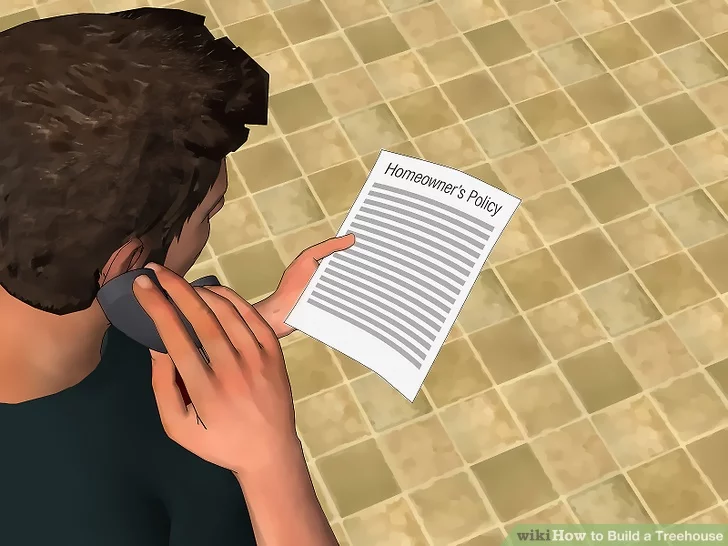

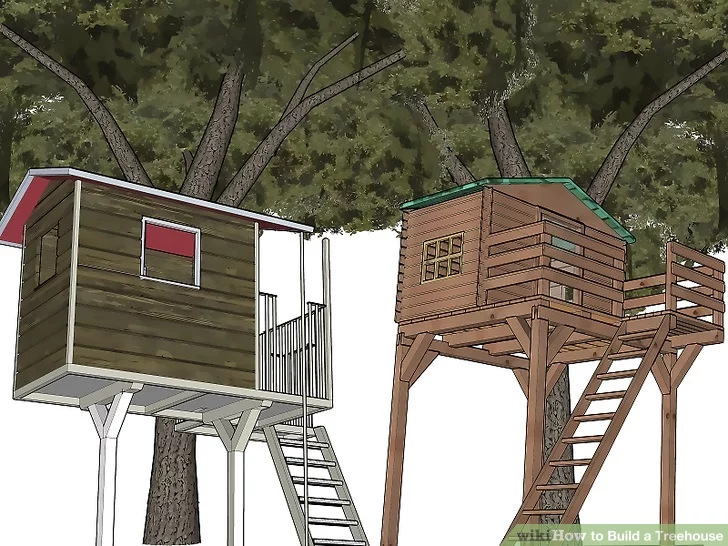


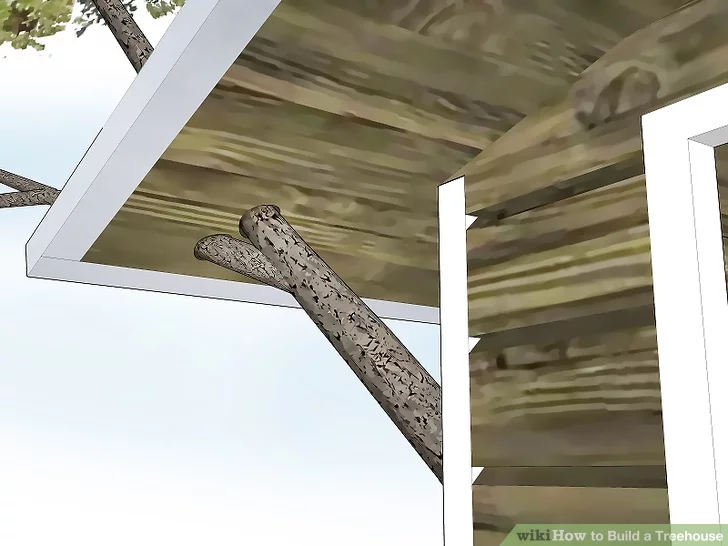

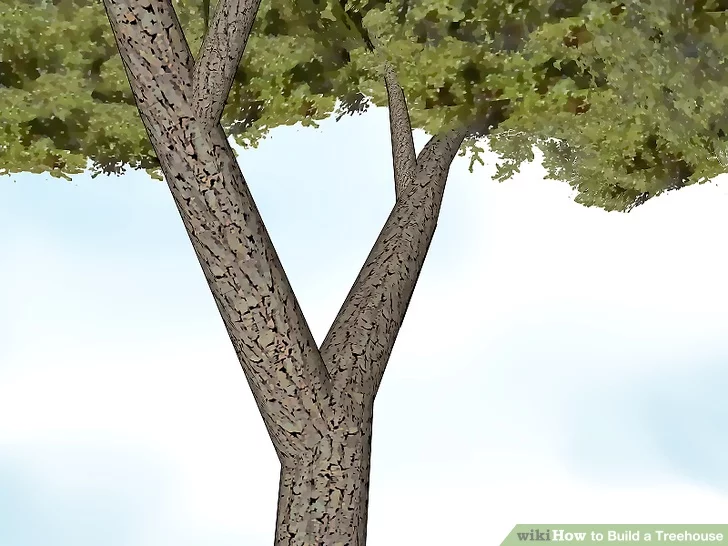


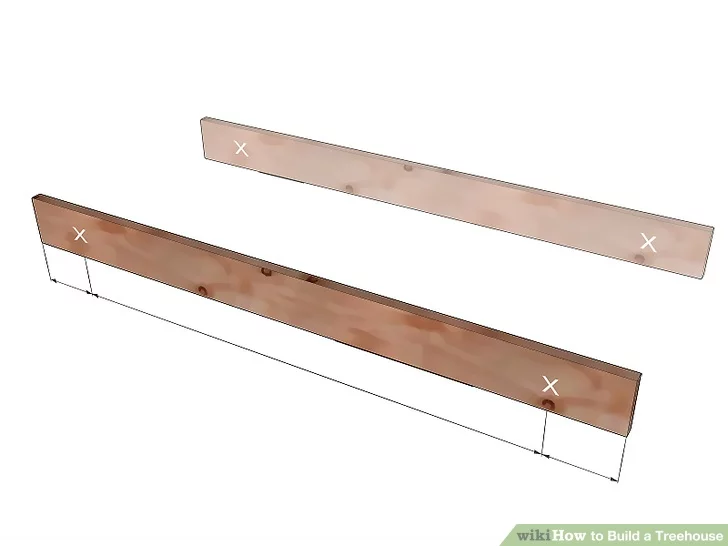






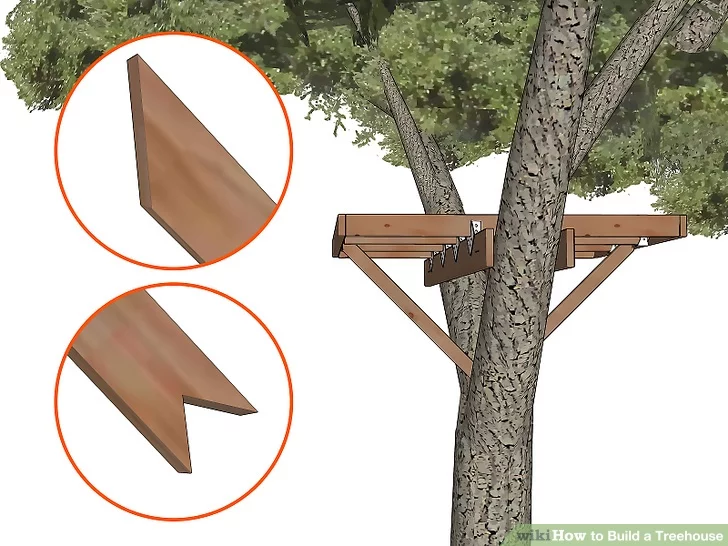






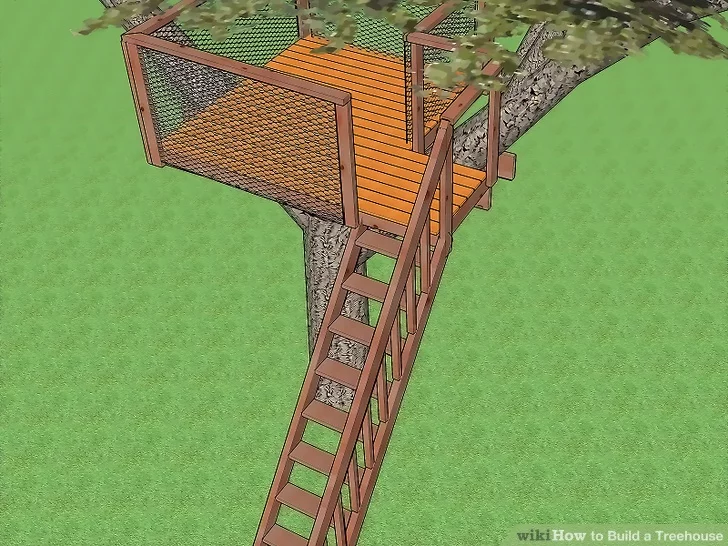
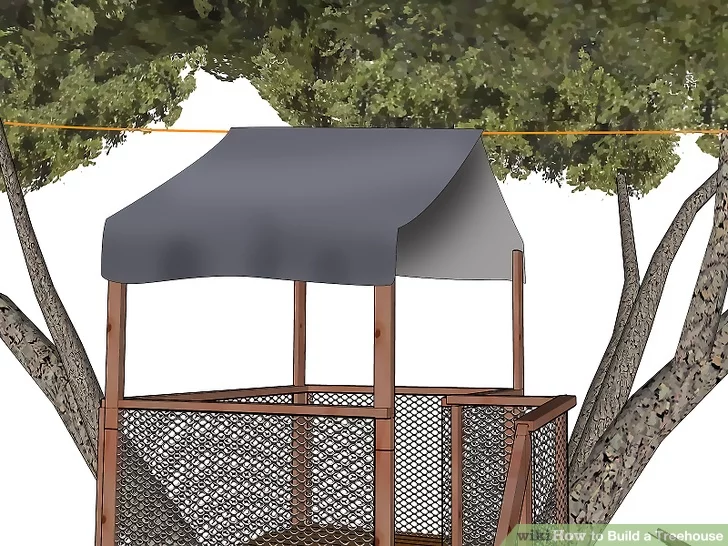
No comments:
Post a Comment